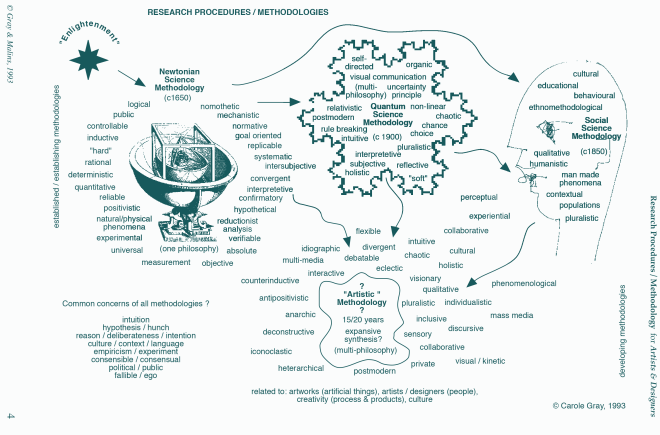
As cited by Gray and Malins(1993), we are now in a combined stage of Quantum Science Methodology[since 1900], and Social Science Methodology[since 1850]. We can distinguish right from wrong, be aware of correction and logic. Meanwhile, we are happy and frequent to look back and criticise the existing rules, not afraid to accept new science and ideas, glad to see change. It is a golden age for artist that have never been better.
The point is, however, what the procedure of art should be formed as. When we mentioned about fine art, which is used to think as an anti-method procedure of creation, actually can be seen as a sequential and even regular one in some ways. Gray(1993) tried to shape it in her essay[attached image]. Likewise, Cornock(1978,1983,1984) pretended to identify it follows:
Generation
Selection
Synthesis
Articulation
Presentation
Critical Discussion
Is the regulation the final revolution of artistic methodology? The answer is no. We can still find some flexible and elastic examples even in a chaos and dilemmatic kind of art – postmodern, to reclaim that dogma is not always sticked on.
Traditionalism and futurism are both honoured and subverted, embraced and eschewed, in a double process of destroying and preserving that which has gone before, towards a new synthesis.
(Hayworth, 1993, np)
What and who should be the reason and the dominance of research and procedure in art? In my point of view, these are all depend on the inspiration and purpose of art, as well as the motivation and method of creation in the specific artefact. Art is such a complicated manifestation that is shaped and formed in centuries, which result in numerous connection and affiliation with culture, religion, humanities and social. This is the reason why it is hard to generalise in one for all, and the reason why it is worth to try.
REFERENCES:
-
Carole, G. and Julian, M. (1993). Research Procedures/Methodology for Artists & Designers. Aberdeen: the Robert Gordon University, p.7.
-
Cornock, S. (1983). ‘Methoddology for Students of Fine Art’. Journal of Art & Design Education, Vol.2, No.1, 1983.
Cornock, S. (1983). ‘Strategies in Fine Art Art’. Journal of Art & Design Education, Vol.3, No.2, 1984.
Cornock, S. (1983). ‘Notes Towards a Methodology for Students of Fine Art’. Leicester Polytechnic Monograph, 1978.
-
Rayworth, A. (1993). Seminar Contributions and Notes, GRU.



